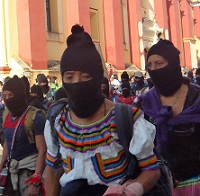
Some twenty thousand members of the bases of the Zapatista Army for National Liberation marched briskly through San Cristobal de las Casas on October 8. They gathered on the outskirts of the city, under a blue sky stained with clouds that threatened rain and then walked in long, orderly lines toward the central plaza of the city.
![]() Source: Americas Program
Source: Americas Program
Some twenty thousand members of the bases of the Zapatista Army for National Liberation marched briskly through San Cristobal de las Casas on October 8. They gathered on the outskirts of the city, under a blue sky stained with clouds that threatened rain and then walked in long, orderly lines toward the central plaza of the city. The long river of Zapatistas moved fluidly and silently; the only sound was the steps of their shoes and boots. They carried signs that read “Your rage is ours”, “Your pain is our pain” and “You are not alone”.
The message was for the students of Ayotzinapa, Guerrero and for the families that found out that on on Sept. 26-27 their sons were killed or kidnapped as they traveled by bus, at the hands of municipal police in complicity with the drug trafficking organization Guerreros Unidos. Two weeks from the attacks there are 6 dead and 43 disappeared.
“In Ayotzinapa the state appears as the intersection between official powers and criminal powers that dispute political control, using new forms of social discipline. We have arrived at a point of dehumanization,” said Dolores González Saravia, director of the NGO SerAPaz, during the presentation of the 2013-2014 report of the Fray Bartolomé de Las Casas Center for Human Rights.
The bone-chilling story of these youth and the indignation at the corruption of the police and the Mexican institutions spurred many acts of solidaryt. Oct. 8 more than 60 cities in Mexico and throughout the world responded to the call to mobilize. They organized marches, roadblocks, occupations and blockades of government offices.
In Chilpancingo, the capital of the state of Guerrero, thousands of students demonstrated, along with teachers and other citizens, while the community police of the Unión de Pueblos Organizados de Guerrero (UPOEG) organized an independent search for the 43 students. In Mexico City 15,000 people joined the march. In Barcelona, New York, Montreal and Buenos Aires they showed pictures of the youth, talked about their personal stories, demanded their appearance alive and punishment for the guilty.
“The institutions are not going to do justice, they won’t bring justice, since the whole chain of command is corrupt, but to demand the appearance of the students alive is a form of pressure to present them if they know where they are. However, even this is not complete justice, because presentation of the missing will not repair the incalculable damage suffered by the students and their families,” one Zapatista supporter who preferred to remain anonymous told us.
In San Cristobal de las Casas members of the Sixth Declaration of the Lacandon Jungle joined students, teachers, famlies and civic organizations that organized two marches that came together in the plaza.
The EZLN route went through the plaza, a where it has a long history, crossing through without stopping. The Zapatistas marched in silence just as they had on Dec. 21, 2013 and May of 2011, when the indigenous organization answered another call in solidarity with the victims of state violence, launched by the Movement for Peace with Justice and Dignity. Then the Zapatistas joined national marches against the war on the cartels started by ex president Felipe Calderón. The Mexican government’s anti-drug crusade, instead of decreasing crime, caused some 100,000 deaths and 30,000 disappeared. Today the country is inundated by corrupt institutions, drug cartels and paramilitary groups; the EZLN leader Galeano, assassinated by paramilitary groups May 2, is one of the victims.
Most of the Zapatistas who marched on Oct. 8 were young, like the students of Ayotzinapa. The tourists that strolled through the streets of the colonial city were amazed at the unexpected procession. The people of San Cristóbal de Las Casas –a historically conservative city–looked out from the stores and restaurants and took pictures of the long march of masked indigenous people. No one spoke, some whispered. One women outside a hotel applauded, shouting, “Long live the people!” and the eyes of some of the Zapatistas smiled behind their masks.
Some 10,000 Zapatistas marched through San Cristobal de las Casas in solidarity with the students of students of Ayotzinapa. “Your rage is ours”. “You are not alone”.
Original photo for the Americas Program by Orsetta Bellani.
